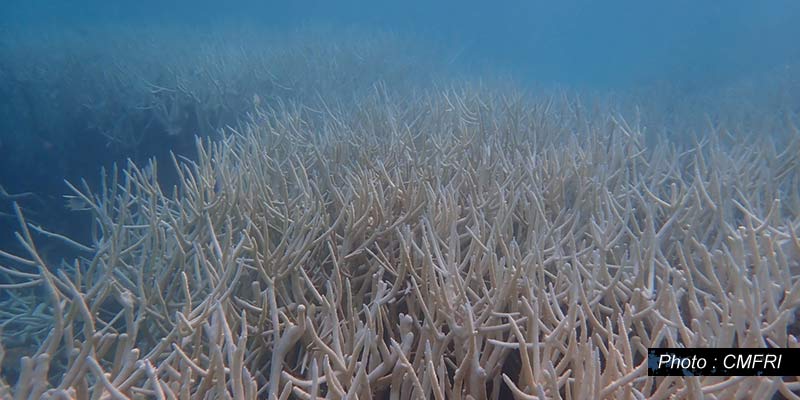- India
- May 07
Explainer - What is coral bleaching?
• According to a new study by the ICAR-Central Marine Fisheries Research Institute (CMFRI), marine heatwaves are triggering widespread bleaching of coral reefs in the Lakshadweep Sea, wherein corals lose their vibrant colours due to stress-a concerning phenomenon.
• Survey results from various Lakshadweep Islands revealed that a considerable percentage of the hard coral species have undergone severe bleaching.
• The bleaching was primarily due to a prolonged period of marine heatwaves affecting the region since late October 2023.
• The health of marine ecosystems is integral to the livelihoods of coastal communities, influencing tourism and fisheries sectors.
• The ongoing marine heatwaves are likely to cause significant economic losses by disrupting their vital ecosystem services.
What is marine heatwave?
• Just like heatwaves on land, heatwaves occur in our oceans.
• When ocean temperatures are exceptionally high in a specific area for an extended period of time, it has the potential to affect the biology and chemistry of an ecosystem.
• Marine heatwaves occur after a period of above average ocean temperatures and can have devastating impacts on marine wildlife, ecosystems and coral reefs.
• One commonly used metric defines a marine heatwave as an event where temperatures exceed the 90th percentile of 30-year historic values for five or more days in a row.
• The temperature of the ocean impacts everything from marine life, to coastal communities, to the stability of polar ecosystems and to weather events such as cyclones and floods.
• Marine heatwaves cause marine habitat destruction due to coral bleaching, seagrass destruction, and loss of kelp forests, affecting the fisheries sector adversely.
• Marine heatwaves are becoming more frequent, longer and dangerous due to climate change.
What is coral bleaching?
• Corals appear to be simple animals that live in colonies; however, they have complex relationships with microbes.
• Of particular importance are zooxanthellae. These are micro algae which live inside a coral’s clear tissue. Known as Symbiodiniaceae, these micro algae receive protection and essential nutrients from their coral host and give them their colour.
• In return, the algae feed corals with sugars produced from photosynthesis. More than 90 per cent of corals’ food requirements come from this solar-powered energy source.
• This mutually beneficial relationship between corals and their tiny algae is a form of symbiosis. It is the reason corals can build an extraordinary variety of growth forms, providing homes to countless other reef animals and plants.
• Corals are sensitive to unusual conditions such as warm or cool water temperatures, low salinity, and pollution. In the case of stressful temperatures, the algal symbiont becomes toxic to the coral animal. The coral animal responds by expelling the symbiotic partner from its tissues as a survival strategy during the heatwave.
• As the algal symbiont leaves the coral, the coral’s thin tissue becomes transparent, revealing its white skeleton underneath. This is known as coral bleaching.
• Not all bleached corals are white. Some severely stressed corals become bright pink, yellow or blue while they are bleaching.
• Bleaching is not always a death sentence for corals. Some corals die, but others can recover, depending on how hot and stressful the water gets, and how long the high temperature persists.
Importance of coral reefs
• Coral reefs are well known as some of the most beautiful, biologically diverse and delicate ecosystems in the world.
• They are also vital to maintaining food supply and protecting the shoreline of low-lying island nations.
• Coral reefs are one of the most vulnerable marine ecosystems.
• Coral reef is known as the “rainforest of the ocean”.
• The United Nations Environment Programme (UNEP) estimates that about 25 to 50 per cent of the world’s coral reefs have been destroyed and another 60 per cent are under threat.
• Some 850 million people live within 100 km of a coral reef and derive some economic benefit from their ecosystem services.
• Although reefs cover only 0.2 per cent of the world’s sea floor, they contain about 25 per cent of marine species. Increases in sea surface temperatures and changes in water chemistry can cause large-scale coral bleaching, increasing the probability of coral death.
• Hence, the effects of climate change, added to other existing coral reef stressors, could lead to coral death.
• Scientists estimate that more than one million species of plants and animals are associated with coral reef ecosystems.
• Reefs also have a role to play when it comes to reducing emissions. While reefs are not a net absorber of CO2, they have a vital role to play.
Manorama Yearbook app is now available on Google Play Store and iOS App Store

